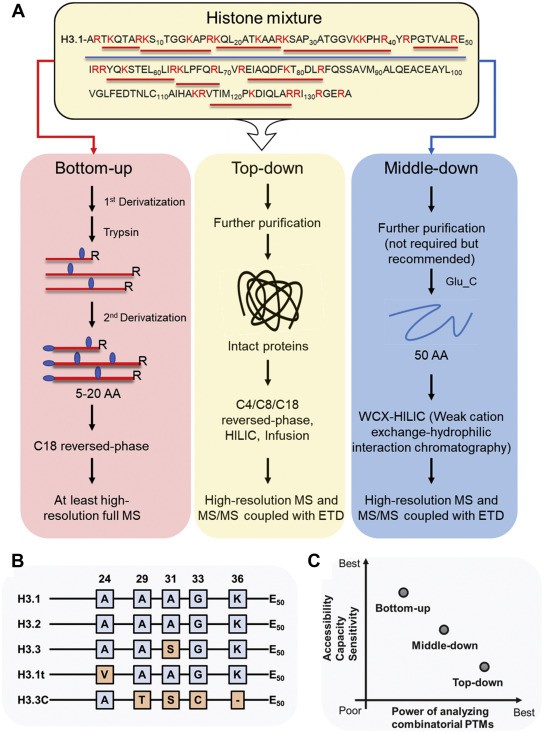Histone post-translational modifications (PTMs) have become one of the hot spots in epigenetic research because of their ability to regulate gene transcription and expression by regulating the structure of chromatin. The abnormal patterns of histone PTMs can lead to defects in these cellular processes, which may result in human disorders, including Alzheimer's disease, autoimmune diseases, and various forms of cancer. Mass spectrometry (MS)-based proteomics workflow has been established to investigate histone PTMs. As laboratory techniques and MS technologies advance, deeper sequencing coverage of protein and histone PTMs can be obtained, generating large amounts of data that need to be analyzed and visualized. Based on sophisticated bioinformatics tools and experienced experts, Creative Proteomics offers a histone PTM data analysis service dedicated to helping researchers and professionals process and analyze histone PTM data efficiently and accurately.
MS-based proteomics methods for the analysis of histone PTMs
To analyze histone PTMs, a variety of MS-based techniques have been applied, including bottom-up, middle-down, and top-down approaches.
- Bottom-up proteomics
Since histones are very basic proteins, containing many lysine and arginine residues in the protein sequence. Typical bottom-up techniques include the purification of histones by acid extraction, derivatization of free amine groups on N-terminal and lysine, and trypsin cleavage. With the optimization of histone extraction, derivatization, MS acquisition method, and data analysis, bottom-up proteomics has been emerging as the most robust and accurate characterization method for the analysis of histone PTMs.
- Middle-down proteomics
The mid-down approach typically uses the digestion enzyme GluC instead of trypsin and is a compromise between bottom-up and top-down proteomics. This technique has been shown to be high-throughput and feasible and is commonly used for polypeptide analysis. And these polypeptides retain more information about the coexisting PTMs and facilitate the analysis of combinatorial histone modifications. - Top-down proteomics
The top-down approach analyzes intact histones without the need for proteolytic digestion prior to MS analysis. Similar to the middle-down approach, top-down proteomics is used to quantify the combinatorial histone PTMs. However, this technique leads to the generation of complex data that makes histone identification and computational analysis challenging.
 Fig. 1 MS-based proteomics analysis of histone PTMs. (Lu, Congcong, et al.)
Fig. 1 MS-based proteomics analysis of histone PTMs. (Lu, Congcong, et al.)
Service offering
We have years of experience in large-scale proteomics research and histone PTM data analysis. Our bioinformatics analysis team keeps up with research advances in bioinformatics analysis methods and has established the industry-leading PTM proteomics analysis platform. Our histone PTM data analysis service can not only help our customers to analyze total protein levels but also allows histone PTM data analysis. According to the specific projects of our customers, we implement customized data analysis and visualization, providing results as data tables, stack bar charts, interactive volcano, heatmaps, and so on.
Advantages of our service
- Providing histones and their PTM data analysis.
- Performing differential analysis between sample conditions.
- Providing publication quality figures, explore interactive plots, and data tables.
- Solving problems with professional knowledge and creativity.
Creative Proteomics is dedicated to the comprehensive and reliable identification and quantification of histone PTMs. Our PTM proteomics analysis platform has a team of experts and state-of-the-art equipment to help you navigate successful research projects through strong workflow, powerful analysis, and tailored services. Need help analyzing your data? We offer affordable biostatistics & bioinformatics services. Contact us right now!
References
- El Kennani, Sara, et al. "Proteomic analysis of histone variants and their PTMs: strategies and pitfalls." Proteomes 6.3 (2018): 29.
- Lu, Congcong, et al. "Accelerating the Field of Epigenetic Histone Modification Through Mass Spectrometry–Based Approaches." Molecular & Cellular Proteomics 20 (2021).
Our products and services are for research use only.


 Fig. 1 MS-based proteomics analysis of histone PTMs. (Lu, Congcong, et al.)
Fig. 1 MS-based proteomics analysis of histone PTMs. (Lu, Congcong, et al.)
